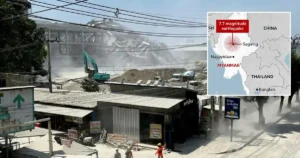In a series of visits to disaster-stricken areas in late January 2025, President Donald Trump proposed a significant shift in the United States’ approach to emergency management, suggesting the potential elimination or substantial overhaul of the Federal Emergency Management Agency (FEMA). This proposal has ignited a nationwide debate on the efficacy of federal disaster response and the roles of state versus federal authorities in managing emergencies.
President Trump’s Critique of FEMA
During his tour of areas affected by Hurricane Helene in North Carolina, President Trump expressed his dissatisfaction with FEMA’s performance. He described the agency as “very bureaucratic and very slow,” emphasizing its high operational costs and perceived inefficiencies. He stated, “I think, frankly, FEMA is not good… FEMA has been a very big disappointment.”
In California, while assessing the aftermath of devastating wildfires in Los Angeles, Trump reiterated his concerns about FEMA’s effectiveness. He criticized the agency’s response times and suggested that disaster management responsibilities might be better handled at the state level, with federal support provided directly to states.
Proposed Changes to Disaster Management
President Trump’s proposal includes dismantling FEMA and reallocating its responsibilities to individual states. He advocates for directing federal disaster assistance funds straight to state governments, bypassing federal bureaucracy. This approach aims to empower states to manage disaster relief efforts more efficiently and tailor responses to their specific needs.
Trump’s plan also involves signing an executive order to initiate the process of overhauling or eliminating FEMA. He has proposed forming a FEMA advisory council to address existing concerns and explore the feasibility of transferring disaster management duties to state authorities.
Reactions from State Officials
The proposal has elicited mixed reactions from state officials, particularly in disaster-prone regions like Florida. State representatives have expressed concerns about the financial burden that managing large-scale disasters would place on individual states without federal assistance. Representative Lindsay Cross of Pinellas County highlighted that the damages from recent hurricanes in Florida amounted to over $220 billion, nearly double the state’s annual budget. She emphasized that handling such costs independently could bankrupt the state.
Senator Carlos Guillermo Smith echoed these concerns, stating, “States just don’t have the resources to handle it alone… we also need support from the federal government because states don’t have unlimited resources.” He suggested that the President’s perspective might change if personally affected by a disaster, referencing the vulnerability of Trump’s Mar-a-Lago estate to hurricanes.
Legal and Logistical Challenges
While the President can propose significant changes to federal agencies, dismantling FEMA would require congressional approval. The agency was established by executive order, and its roles and responsibilities are defined by Congress. Therefore, any attempt to eliminate or substantially overhaul FEMA would necessitate legislative action, presenting legal and logistical challenges.
Criticism from Disaster Response Experts
Experts in disaster response have raised concerns about the proposal to eliminate FEMA. Shana Udvardy, a senior climate resilience policy analyst at the Union of Concerned Scientists, compared the suggestion to banning hospitals, stating, “If we abolish federal funding for disaster assistance, municipalities and states wouldn’t be able to cover these types of catastrophic emergencies and people would be left to fend on their own.”
Former FEMA officials have also criticized the proposal, arguing that abolishing the agency would negatively impact disaster response capabilities nationwide. They emphasize the importance of a coordinated federal response to manage large-scale emergencies effectively.
Political Implications
President Trump’s proposal has rekindled contentious discussions on federal disaster response, state versus federal authority, and the role of climate change in exacerbating natural disasters. His actions and comments have highlighted the ongoing debate over the most effective strategies for managing disaster preparedness and response in the United States.
Conclusion
The suggestion to eliminate or overhaul FEMA represents a significant shift in U.S. disaster management policy. While aimed at reducing bureaucracy and increasing efficiency, the proposal has raised concerns about the capacity of individual states to handle large-scale disasters without federal support. As the debate continues, it underscores the complex balance between federal and state responsibilities in ensuring effective disaster preparedness and response.






